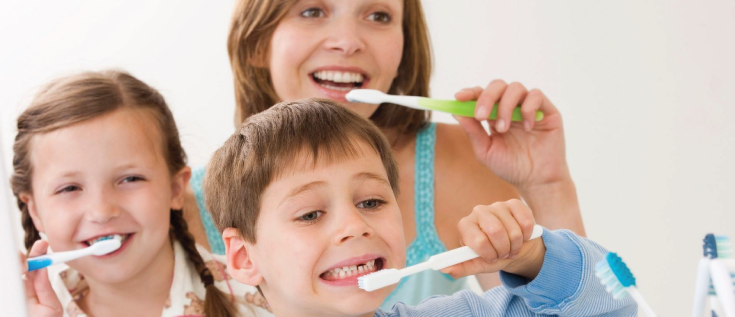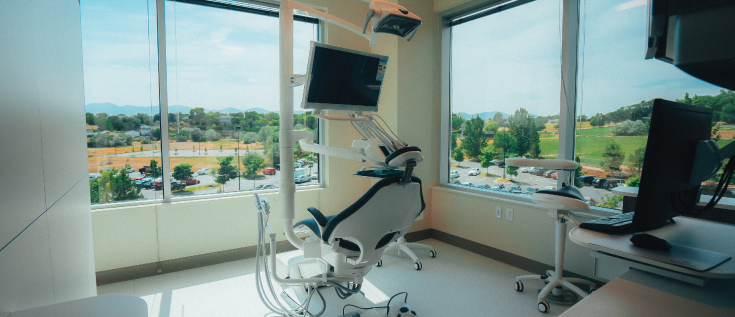
by Roseman Dental | May 11, 2022 | Dental 360, Dental Clinic Blog, Oral Health, Roseman Dental - NV, Roseman Dental - UT
One of the biggest advantages to living in the digital age is the overwhelming amount of information that is just a click away. However, with so much discussion regarding almost every topic imaginable, it is easy to understand why so many rumors and myths get passed around. Since the dental arena is not immune to perpetual misinformation, here are three common myths debunked:
Dental Myth #1
A fancier or more expensive toothbrush results in cleaner, healthier teeth.
The Truth
It is not the type of toothbrush you use, but the manner in which you use it that makes all the difference. Brushing twice a day for two minutes at a time is the key to healthier teeth and gums. This can be easily accomplished whether you opt to use a simple, soft bristle manual toothbrush, or a higher-end electric one. The most important factor is to be comfortable with your selection and use it on a consistent basis.
Dental Myth #2
The harder you brush, the better your results.
The Truth
Brushing your teeth harder does not improve your oral health. In fact, it can have potentially damaging effects! Excessive brushing with aggressive force can lead to enamel loss and gum recession, which can ultimately expose roots and cause sensitivity and tooth decay. If you are unsure if you are a harsh brusher, talk with your dentist so they can assess your routine and provide helpful suggestions. Part of an assessment by a dentist involves measurement and scoring of any potential gum recession. These measurements are taken at each visit and compared against each other to identify long-term recession.
Dental Myth #3
Regular brushing eliminates the need for regular dental cleanings.
The Truth
Plaque, a biofilm with a soft mashed potato-like consistency, begins to form on your teeth within 20 minutes after eating. If it isn’t brushed away within eight hours, it hardens into tarter that brushing cannot remove. Tarter build-up leads to gum disease and tooth decay. Only a dentist or dental hygienist will have the tools necessary to properly and effectively remove tarter from the teeth.
When it comes to oral health, false information can be damaging. The most important way to make your dental health a priority is by seeking out a reputable dentist who can dispel myths and provide you with the facts. Your mouth will thank you for it.

by Roseman Dental | May 10, 2022 | Dental 360, Dental Clinic Blog, Dental School, Oral Health, Roseman Dental - UT
The College of Dental Medicine at Roseman University of Health Sciences has opened a new state-of-the-art clinical floor of Roseman Dental, the clinical practice of Roseman University College of Dental Medicine, South Jordan, Utah location.
This clinical floor is dedicated to Team-Based Education, which is a new education model that focuses on team practice rather than the traditional single-practice model widely used throughout the United States.
As an expansion to the existing Roseman Dental clinical space, the Team-Based Education clinical floor shares the same high-quality patient-centered operating procedures, general and specialty dentistry services, and affordable pricing.
However, there are very distinct differences between the two clinical spaces. In the existing clinic space, the faculty dentist, dental hygienist, and dental assistants oversee the students in providing direct patient care and treatment while students fill the support positions.
The Team-Based Education clinical floor puts a fresh perspective on this traditional teaching model. The new model allows the faculty dentist and dental hygienist to directly provide team-based general dentistry care to patients and teach students their initial procedures in the clinic.
“Since the pandemic began, we have seen a higher demand for flexible healthcare service,” said Dr. Frank Licari, Dean of the Roseman University College of Dental Medicine. “There has been an expansion of urgent care clinics, telemedicine and drive-thru testing and vaccination facilities. Dental practices will also have to evolve to meet patient demands that want more convenient hours and services. We are dedicated at Roseman to prepare our graduates to be successful in that new dental practice environment.”
Dental assistants are more actively engaged in providing direct chairside assistance to the providers. Students continue to rotate and train through all support positions, including dental assistant and hygienist, emphasizing learning how to treat a volume of patients as a dentist, thus creating a student “Team-Based” educational model and service delivery in a clinical setting.
This updated perspective is the vision of an educational model that prepares graduates for a future-ready group practice environment. As such, Roseman is developing a futuristic faculty educator and a highly efficient person-centered care delivery system in which student learning and assessment occur without compromising overall patient care outcomes.
Each team has eight students and one faculty dentist (Team-Based Educator) to treat assigned patients. The faculty dentist is accountable for the patients progressing through treatment and actively interacting with students by demonstrating and providing probing questions to assess student knowledge and progress through competence.
“This team-based education model will lead dental practices to serve a higher volume of patients per day,” Dr. Licari said. “Our students now see six to eight patients a day, compared to the traditional teaching model which students could only see two patients a week.”
Students are paired in teams based on the provider’s patient needs and skill level, and all procedures have a recommended time interval for completion. The vision and significant focus of the clinic are to provide person-centered care at maximum efficiency. Efficiency is collected via integrated technology throughout the clinic and assessed under specific quality control measures.
As part of Roseman’s commitment to graduate future-ready practitioners, the Team-Based Education clinical floor is significantly focusing on technology integration through all aspects of the clinic. The clinic is equipped with collaborative student workspaces with large interactive digital screens, digital signage, scheduling displays, etc. It has built-in innovative Bluetooth technology with data-collecting sensors to optimize operational efficiency, student education, and patient care. Patient appointments are monitored for efficiency, timeliness, and overall patient satisfaction.
Roseman believes the Team-Based Education clinical floor’s educational model is the future of dental education and will serve as a model moving forward.


